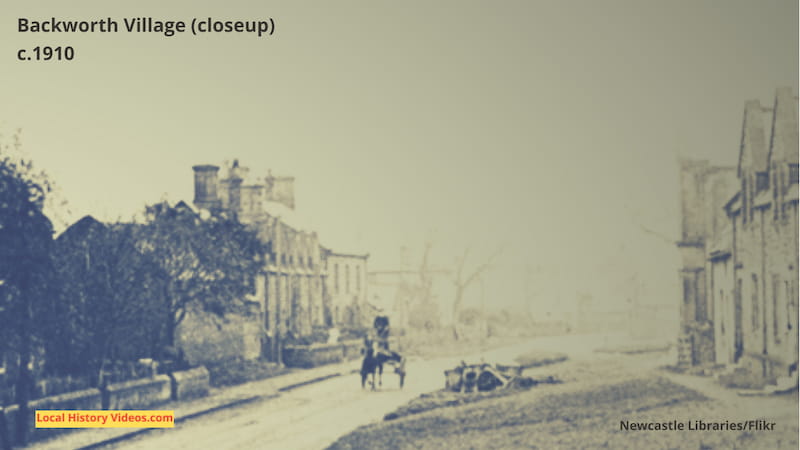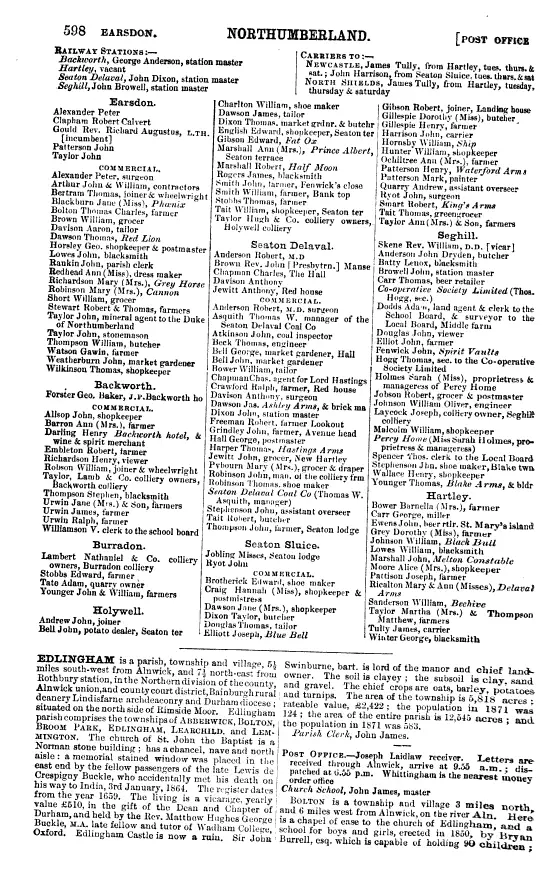Glimpse history through old images of Backworth, in North Tyneside, Tyne and Wear, North East England.
Backworth’s Roman Hoard
In 1812, near to the village, a hoard of gold and silver items was discovered. The items were sold to various parties before most of them ended up in the British Museum, so we know that the hoard was probably buried in about 140 A.D.
The items included :
- a silver skillet, with an inscription of dedication to the mother-goddesses, containing a pair of silver-gilt trumpet brooches
- a second silver skillet
- a gold ring with with an inscription of dedication to the mother-goddesses
- another four gold rings
- one silver ring
- one gold bracelet
- two gold chains with wheel-shaped pendant, and a crescent attached,
- three silver spoons
- 280+ Roman denarii
- two first brass coins of Antoninus Pius
- a white bronze mirror, which had been used to cover the hoard
- an oval silver dish 18 inches long, which did not reach the British Museum
- 2 pieces of a silver bridle bit, which did not reach the British Museum
Tynemouth Priory Manor
King Richard I confirmed Tynemouth Priory in possession of their lands in 1189, when there seems to have been two settlements called Backworth.
The Tynemouth Priory manors of the 1264 assessment roll didn’t include a mention of Backworth.
However, Backworth was included as one of the ten manors belonging to Tynemouth Priory, in the assessment roll of 1292. There’s not enough information to know if it referred to farm buildings, or a building located close to the Backworth Hall still standing today, but four taxpayers are recorded in that year’s lay subsidy roll.
West Backworth
A record from 1306 mentions both East and West Backworth.
West Backworth is mentioned in a record in 1353, but disappeared before the records of Henry VIII’s Dissolution of the Monasteries 1536-1541, possibly losing its name during Tynemouth Priory’s estate reorganisation in the previous century.
All that is left of the village are subtle changes to the ground immediately to the south of Backworth Lane, visible from the air.
From these, archaeologists can see the vanished village once had a row of crofts along both sides of a street which ran east to west. Remains of the ridge and furrow system show the residents ploughed the arable land around them.
Coal Mining
North East England was in its heyday during the Industrial Revolution, thanks mainly to the rich coal seams powering the emerging industrial economy.
We can see the village prominently named in this extract of a map from 1852, in the area marked for ‘Coal-Measures’.

In 1950, the collieries in and around Backworth employed 2,905 people.
Backworth Colliery even had its own railway system, which used steam locomotives right into the 1970s.
By then, a few colliery workers had begun their own heritage steam rescue programme, using a lean-to on the side of the colliery’s engine shed to store steam locomotives rescued from elsewhere.
Eccles Colliey, at 1,440 ft, was the deepest pit in the Northumberland Coalfield, and was the last of Backworth’s collieries to close, with the final shift ending in 1980.

Backworth Hall
Backworth Hall was built in 1778 for wealthy landowner Ralph William Grey, with a design by William Newton.
The Duke of Northumberland purchased the while of the Grey Estate following a dispute over the rights to work coal in the Backworth area.
By 1934, Backworth Hall had falled into disrepair. So the Backworth Colliery Miners Welfare Scheme purchased the hall and its grounds, to create a social centre called the Backworth Miners Welfare Hall.
They spent £8,500 on buying the Hall, buildings and grounds. Then they spent £4,000 on restoration and alterations, plus a further £4,415 on additional recreational facilities, including the golf course.
The Social Fund collected sixpence from each of the miners in the area, and used the funds to run the hall and activities there for its members .

Backworth Village



Tyne and Wear Metro
The Metro test track was built at Middle Engine Lane, on what had been the rail line from the colliery to the staithes, where coal was loaded onto ships.
Middle Engine Lane was named after one of the stationary haulage engines used before the introduction of locomotives in the mid-19th century. Today it’s home to the North Tyneside Steam Railway.
In 1980 Backworth had a Tyne and Wear Metro Station, but lack of passengers meant it closed, so Northumberland Park station is now the nearest Tyne and Wear Metro Station to the village.

The Post Office Directory of Durham and Northumberland
by Kelly and Company
Published in 1879


More about Tyne and Wear
- Cowgate, Newcastle Upon Tyne: History in Old ImagesEnjoy a glimpse of history through old images of Cowgate, in Newcastle upon Tyne, Tyne & Wear, England, UK.
- Willington, North TynesideEnjoy a glimpse of history about Willington in North Tyneside, Tyne & Wear, North East England, UK.
- Newburn, Newcastle upon TyneEnjoy a glimpse of history about Newburn in Newcastle upon Tyne, Tyne & Wear, North East England, UK.
- Howdon, North TynesideEnjoy a glimpse of history about Howdon in North Tyneside, Tyne & Wear, North East England, UK.
- Fawdon, Newcastle upon TyneEnjoy a glimpse of history about Fawdon in Newcastle upon Tyne, Tyne & Wear, North East England, UK.
- Coxlodge, Newcastle upon TyneEnjoy a glimpse of history about Coxlodge in Newcastle upon Tyne, Tyne & Wear, North East England, UK.
- Earsdon, North TynesideEnjoy a glimpse of history about Earsdon in North Tyneside, Tyne & Wear, North East England, UK.
- Dinnington, Newcastle upon TyneEnjoy a glimpse of history about Dinnington in Newcastle upon Tyne, Tyne & Wear, North East England, UK.
- Chirton, North East EnglandEnjoy a glimpse of history about Chirton in North Shields, Tyne & Wear, North East England, UK.
- Usworth, Tyne & WearEnjoy a glimpse of history about Usworth in Washington, Tyne & Wear, England, UK.




